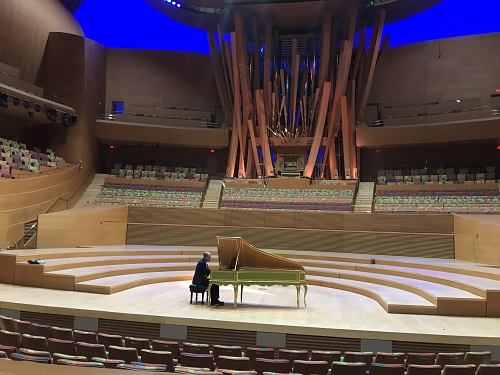 United States Colburn Celebrity Recital – Byrd, Bach, Andriessen, Scarlatti: Mahan Esfahani (harpsichord). Walt Disney Concert Hall, Los Angeles, 8.12.2021. (LV)
United States Colburn Celebrity Recital – Byrd, Bach, Andriessen, Scarlatti: Mahan Esfahani (harpsichord). Walt Disney Concert Hall, Los Angeles, 8.12.2021. (LV)

Byrd – Pavan and Galliard from ‘Sir William Petre’; ‘John Come Kiss Me Now’; ‘Ut-re-mi-fa-sol-la’ BK 64
J.S. Bach – Partita No.6 in E minor BWV830
Andriessen – ‘Overture to Orpheus’
Scarlatti – Sonatas K.259, K.260, K.213, K.214, K.516, K.420, K.421
Alone on the stage at Walt Disney Concert Hall, Mahan Esfahani sat at a simple two-manual harpsichord and played as if every single tone touched something sensitive in his soul. He invested music by Bach and Byrd with the power and gravity we associate with Beethoven’s late piano sonatas, and he followed a tasty bit of Dutch modern with dour Scarlatti off the beaten track. The sponsoring Colburn Music School’s Zipper Hall would have better suited the instrument and the artist, but its 415 seats wouldn’t have accommodated the estimated, very fortunate 600 who showed up. And while the harpsichord sounded a little small, Esfahani’s exquisite touch and the sparkling clarity with which he played as he built his sound up from the instrument’s warm bass, with a very legato approach to articulation, insured that nothing was lost except the most delicate nuances of how the mood or momentum was affected by the different tone qualities of the three registers, two 8-foot and one 4-foot stop.
The Byrd set was something special, with a sad, formal elegance that held the audience transfixed as much by the simple openings as by the quicksilver bursts of virtuosity which Esfahani spun out as if he were making them up.
Treated this way, with a subjective intensity linked to a superb command of narrative and a love affair with the unique sound universe of the harpsichord, Bach’s Partita in E minor was titanic. It took a while for the music to settle down in the opening Toccata, but Esfahani was soon creating miracles like the marvelous strings of pearls before the double bars in the Allemande, working his way like a spider through the formal dances.
Louis Andriessen’s hypnotically intricate ‘Overture to Orpheus’ (1982) was linked in a way to the Bach, each seeming inspired by the dance, and it made the perfect interloper before Esfahani launched into seven sonatas by Domenico Scarlatti.
Only two were in minor keys, but Esfahani so deeply internalized the process by which Scarlatti’s two-part formula created their primitive development that what you heard was less the surface charms, which were few, and more the emotional power generated by the tension between the two sections during which seriously schizophrenic moments might introduce light-footed dancing. After a strange and wonderful Tempo di Gavotta, Esfahani finished with a festive Gigue spectacularly conflicted over meter. He played Purcell’s ‘Ground in C minor’ for the encore.
The harpsichord was a generic eighteenth-century French model built in 2018 by Los Angeles maker Curtis Berak; he made the case during the pandemic. Berak, who is also a hurdy-gurdy virtuoso, used ‘French principles and similar materials made slightly larger and going to a high G so it could play all of the Scarlatti sonatas – no French harpsichords went higher than F’.
Laurence Vittes